Report on Sustainable Tourism Development: Philippines Case Study
VerifiedAdded on 2020/01/16
|19
|5537
|215
Report
AI Summary
This report delves into the multifaceted aspects of sustainable tourism development, focusing on the Philippines as a case study. It begins by examining the benefits of tourism planning for various stakeholders, including local communities, government bodies, employees, tourists, and residents, and contrasts the advantages and disadvantages of public and private sector involvement in the tourism industry. The report then explores the features of tourism development planning at different levels (international, national, and regional), emphasizing the significance of interactive planning systems and processes. Furthermore, it addresses the concept of sustainability in tourism, discussing its importance, the issues surrounding it, and the various stages of sustainable tourism development planning. The report also tackles issues arising from conflicts of interest, evaluates methods for resolving these concerns, and discusses the implications of sustainable tourism development for balancing supply and demand, as well as the moral and ethical issues of enclave tourism. Finally, it compares current issues related to tourism development and suggests recommendations for the future development of tourism in the Philippines.
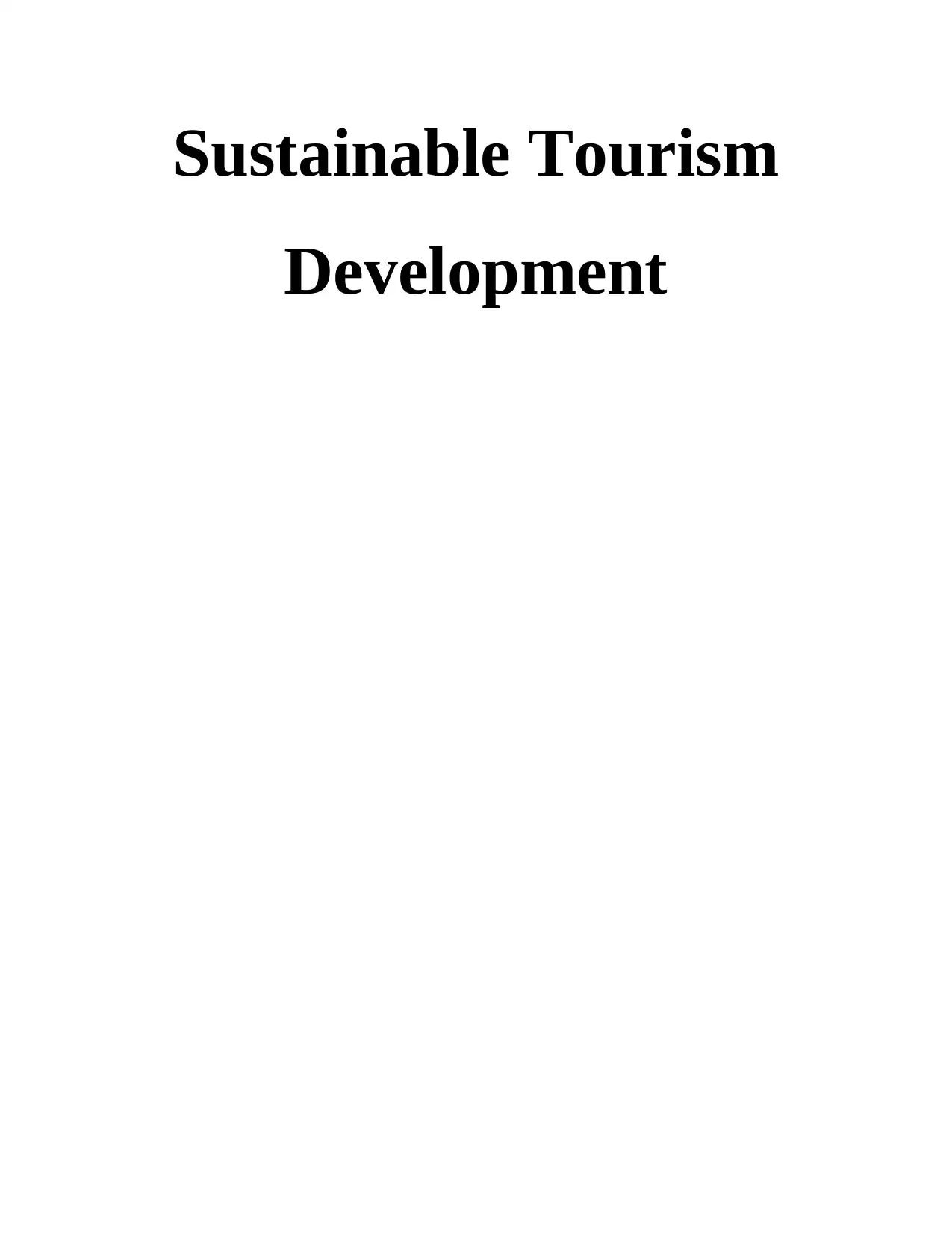
Sustainable Tourism
Development
Development
Paraphrase This Document
Need a fresh take? Get an instant paraphrase of this document with our AI Paraphraser
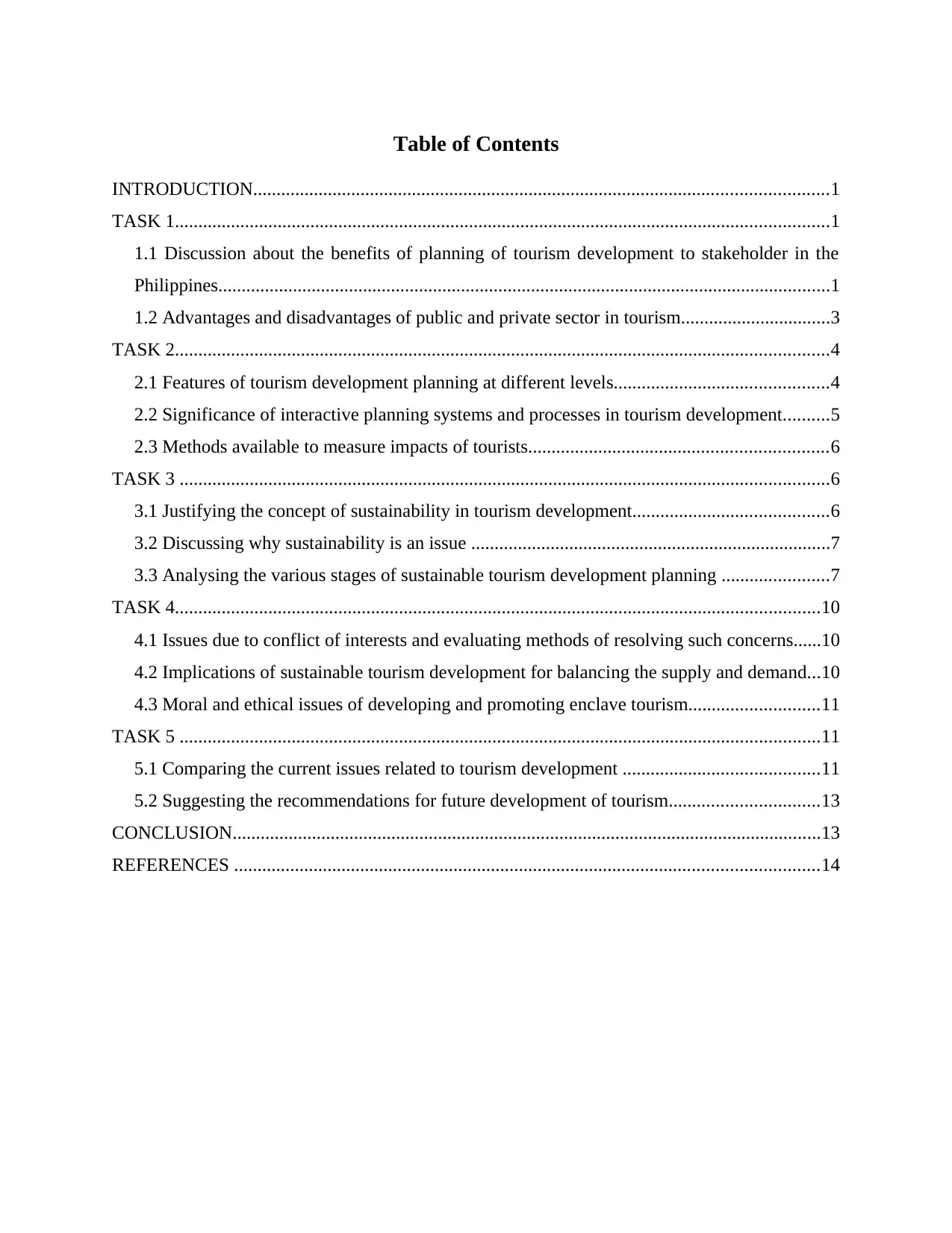
Table of Contents
INTRODUCTION...........................................................................................................................1
TASK 1............................................................................................................................................1
1.1 Discussion about the benefits of planning of tourism development to stakeholder in the
Philippines...................................................................................................................................1
1.2 Advantages and disadvantages of public and private sector in tourism................................3
TASK 2............................................................................................................................................4
2.1 Features of tourism development planning at different levels..............................................4
2.2 Significance of interactive planning systems and processes in tourism development..........5
2.3 Methods available to measure impacts of tourists................................................................6
TASK 3 ...........................................................................................................................................6
3.1 Justifying the concept of sustainability in tourism development..........................................6
3.2 Discussing why sustainability is an issue .............................................................................7
3.3 Analysing the various stages of sustainable tourism development planning .......................7
TASK 4..........................................................................................................................................10
4.1 Issues due to conflict of interests and evaluating methods of resolving such concerns......10
4.2 Implications of sustainable tourism development for balancing the supply and demand...10
4.3 Moral and ethical issues of developing and promoting enclave tourism............................11
TASK 5 .........................................................................................................................................11
5.1 Comparing the current issues related to tourism development ..........................................11
5.2 Suggesting the recommendations for future development of tourism................................13
CONCLUSION..............................................................................................................................13
REFERENCES .............................................................................................................................14
INTRODUCTION...........................................................................................................................1
TASK 1............................................................................................................................................1
1.1 Discussion about the benefits of planning of tourism development to stakeholder in the
Philippines...................................................................................................................................1
1.2 Advantages and disadvantages of public and private sector in tourism................................3
TASK 2............................................................................................................................................4
2.1 Features of tourism development planning at different levels..............................................4
2.2 Significance of interactive planning systems and processes in tourism development..........5
2.3 Methods available to measure impacts of tourists................................................................6
TASK 3 ...........................................................................................................................................6
3.1 Justifying the concept of sustainability in tourism development..........................................6
3.2 Discussing why sustainability is an issue .............................................................................7
3.3 Analysing the various stages of sustainable tourism development planning .......................7
TASK 4..........................................................................................................................................10
4.1 Issues due to conflict of interests and evaluating methods of resolving such concerns......10
4.2 Implications of sustainable tourism development for balancing the supply and demand...10
4.3 Moral and ethical issues of developing and promoting enclave tourism............................11
TASK 5 .........................................................................................................................................11
5.1 Comparing the current issues related to tourism development ..........................................11
5.2 Suggesting the recommendations for future development of tourism................................13
CONCLUSION..............................................................................................................................13
REFERENCES .............................................................................................................................14
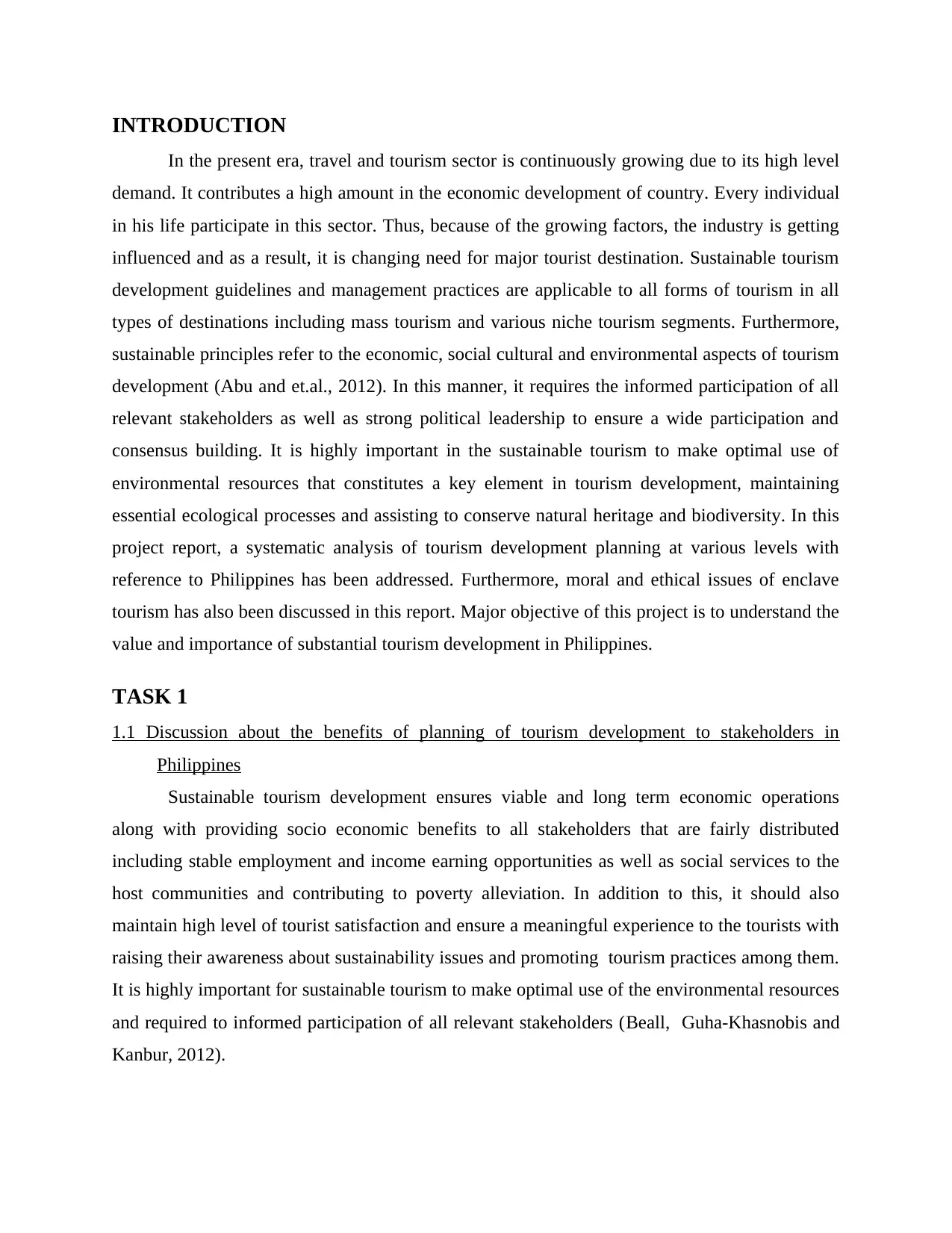
INTRODUCTION
In the present era, travel and tourism sector is continuously growing due to its high level
demand. It contributes a high amount in the economic development of country. Every individual
in his life participate in this sector. Thus, because of the growing factors, the industry is getting
influenced and as a result, it is changing need for major tourist destination. Sustainable tourism
development guidelines and management practices are applicable to all forms of tourism in all
types of destinations including mass tourism and various niche tourism segments. Furthermore,
sustainable principles refer to the economic, social cultural and environmental aspects of tourism
development (Abu and et.al., 2012). In this manner, it requires the informed participation of all
relevant stakeholders as well as strong political leadership to ensure a wide participation and
consensus building. It is highly important in the sustainable tourism to make optimal use of
environmental resources that constitutes a key element in tourism development, maintaining
essential ecological processes and assisting to conserve natural heritage and biodiversity. In this
project report, a systematic analysis of tourism development planning at various levels with
reference to Philippines has been addressed. Furthermore, moral and ethical issues of enclave
tourism has also been discussed in this report. Major objective of this project is to understand the
value and importance of substantial tourism development in Philippines.
TASK 1
1.1 Discussion about the benefits of planning of tourism development to stakeholders in
Philippines
Sustainable tourism development ensures viable and long term economic operations
along with providing socio economic benefits to all stakeholders that are fairly distributed
including stable employment and income earning opportunities as well as social services to the
host communities and contributing to poverty alleviation. In addition to this, it should also
maintain high level of tourist satisfaction and ensure a meaningful experience to the tourists with
raising their awareness about sustainability issues and promoting tourism practices among them.
It is highly important for sustainable tourism to make optimal use of the environmental resources
and required to informed participation of all relevant stakeholders (Beall, Guha-Khasnobis and
Kanbur, 2012).
In the present era, travel and tourism sector is continuously growing due to its high level
demand. It contributes a high amount in the economic development of country. Every individual
in his life participate in this sector. Thus, because of the growing factors, the industry is getting
influenced and as a result, it is changing need for major tourist destination. Sustainable tourism
development guidelines and management practices are applicable to all forms of tourism in all
types of destinations including mass tourism and various niche tourism segments. Furthermore,
sustainable principles refer to the economic, social cultural and environmental aspects of tourism
development (Abu and et.al., 2012). In this manner, it requires the informed participation of all
relevant stakeholders as well as strong political leadership to ensure a wide participation and
consensus building. It is highly important in the sustainable tourism to make optimal use of
environmental resources that constitutes a key element in tourism development, maintaining
essential ecological processes and assisting to conserve natural heritage and biodiversity. In this
project report, a systematic analysis of tourism development planning at various levels with
reference to Philippines has been addressed. Furthermore, moral and ethical issues of enclave
tourism has also been discussed in this report. Major objective of this project is to understand the
value and importance of substantial tourism development in Philippines.
TASK 1
1.1 Discussion about the benefits of planning of tourism development to stakeholders in
Philippines
Sustainable tourism development ensures viable and long term economic operations
along with providing socio economic benefits to all stakeholders that are fairly distributed
including stable employment and income earning opportunities as well as social services to the
host communities and contributing to poverty alleviation. In addition to this, it should also
maintain high level of tourist satisfaction and ensure a meaningful experience to the tourists with
raising their awareness about sustainability issues and promoting tourism practices among them.
It is highly important for sustainable tourism to make optimal use of the environmental resources
and required to informed participation of all relevant stakeholders (Beall, Guha-Khasnobis and
Kanbur, 2012).
⊘ This is a preview!⊘
Do you want full access?
Subscribe today to unlock all pages.

Trusted by 1+ million students worldwide
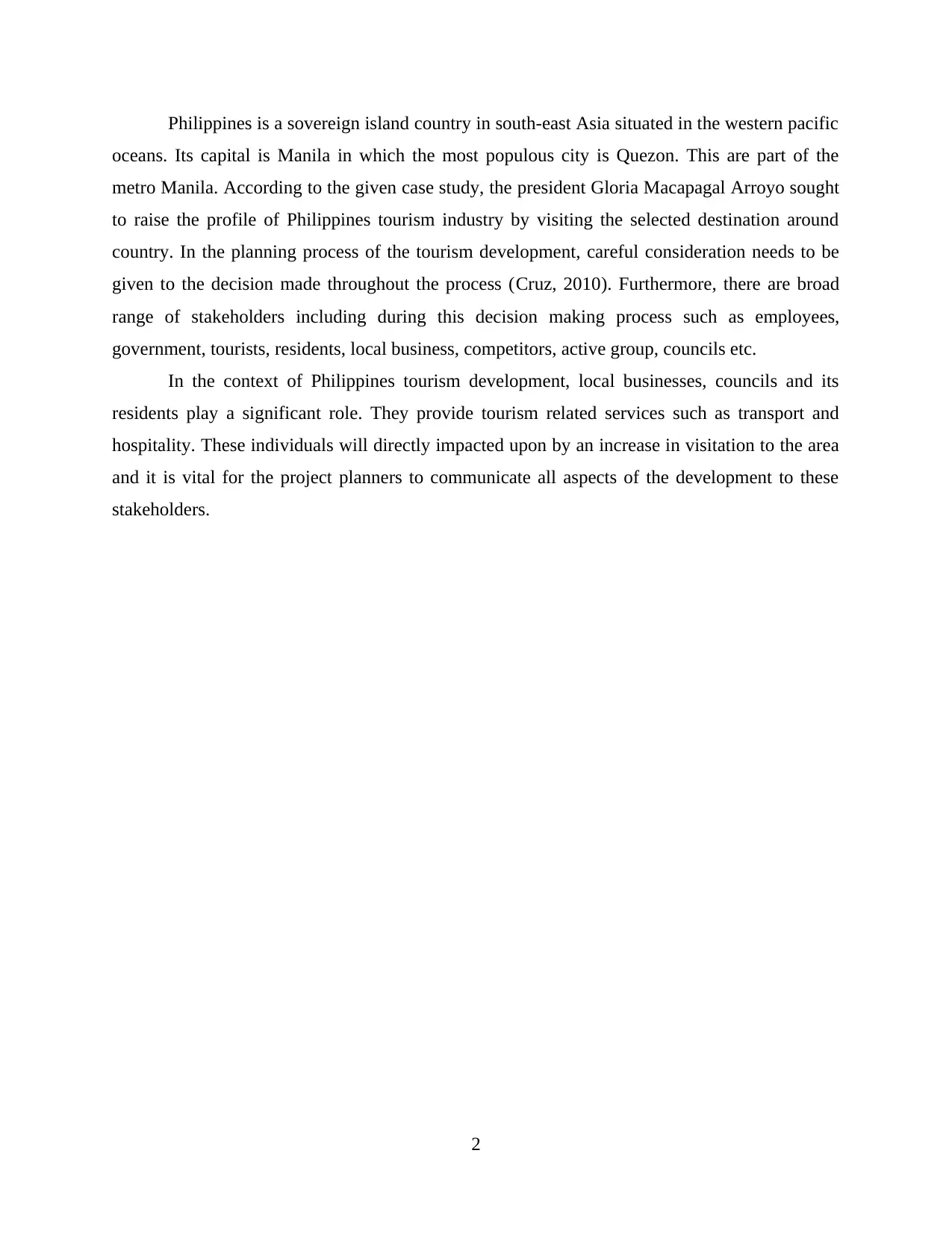
Philippines is a sovereign island country in south-east Asia situated in the western pacific
oceans. Its capital is Manila in which the most populous city is Quezon. This are part of the
metro Manila. According to the given case study, the president Gloria Macapagal Arroyo sought
to raise the profile of Philippines tourism industry by visiting the selected destination around
country. In the planning process of the tourism development, careful consideration needs to be
given to the decision made throughout the process (Cruz, 2010). Furthermore, there are broad
range of stakeholders including during this decision making process such as employees,
government, tourists, residents, local business, competitors, active group, councils etc.
In the context of Philippines tourism development, local businesses, councils and its
residents play a significant role. They provide tourism related services such as transport and
hospitality. These individuals will directly impacted upon by an increase in visitation to the area
and it is vital for the project planners to communicate all aspects of the development to these
stakeholders.
2
oceans. Its capital is Manila in which the most populous city is Quezon. This are part of the
metro Manila. According to the given case study, the president Gloria Macapagal Arroyo sought
to raise the profile of Philippines tourism industry by visiting the selected destination around
country. In the planning process of the tourism development, careful consideration needs to be
given to the decision made throughout the process (Cruz, 2010). Furthermore, there are broad
range of stakeholders including during this decision making process such as employees,
government, tourists, residents, local business, competitors, active group, councils etc.
In the context of Philippines tourism development, local businesses, councils and its
residents play a significant role. They provide tourism related services such as transport and
hospitality. These individuals will directly impacted upon by an increase in visitation to the area
and it is vital for the project planners to communicate all aspects of the development to these
stakeholders.
2
Paraphrase This Document
Need a fresh take? Get an instant paraphrase of this document with our AI Paraphraser
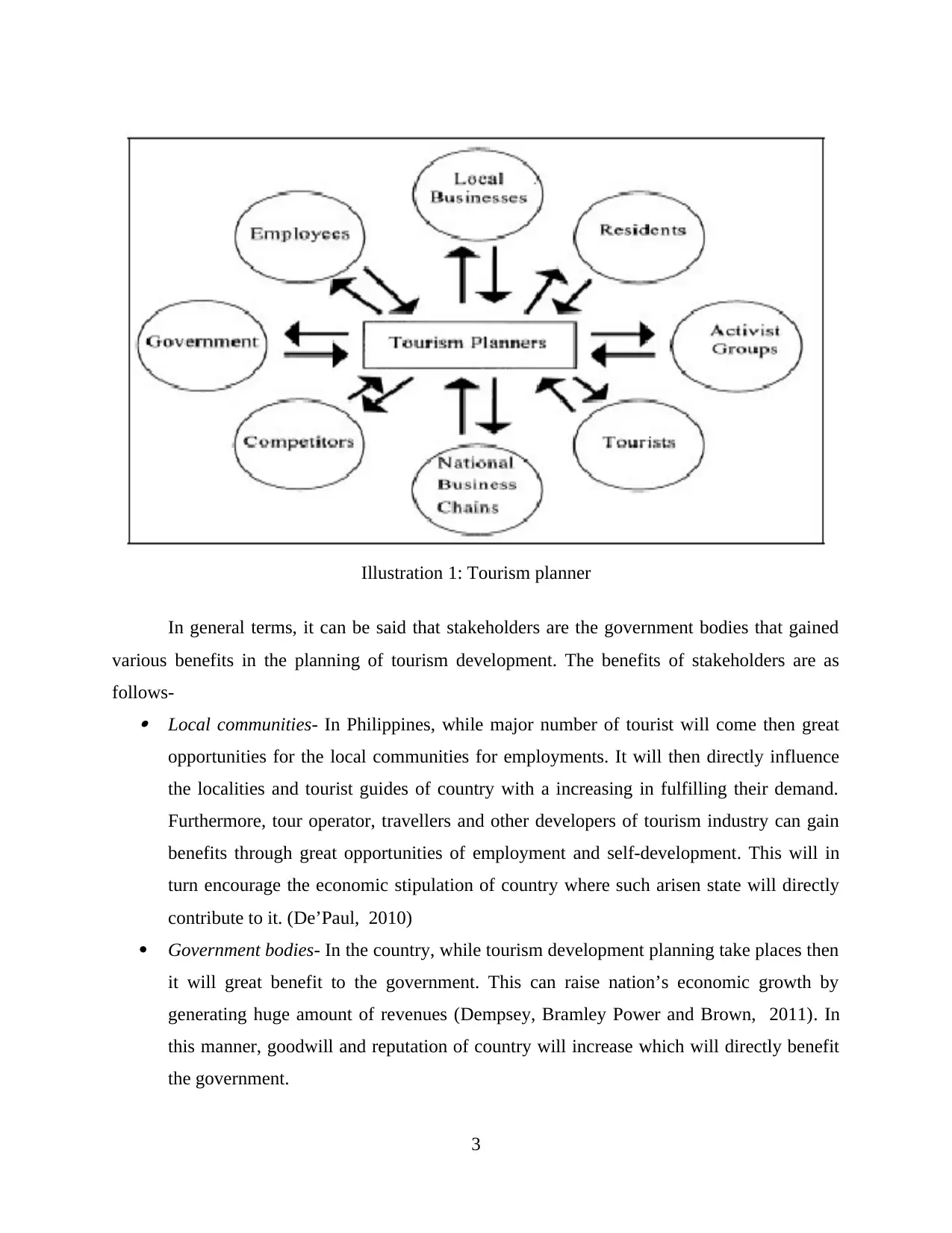
In general terms, it can be said that stakeholders are the government bodies that gained
various benefits in the planning of tourism development. The benefits of stakeholders are as
follows- Local communities- In Philippines, while major number of tourist will come then great
opportunities for the local communities for employments. It will then directly influence
the localities and tourist guides of country with a increasing in fulfilling their demand.
Furthermore, tour operator, travellers and other developers of tourism industry can gain
benefits through great opportunities of employment and self-development. This will in
turn encourage the economic stipulation of country where such arisen state will directly
contribute to it. (De’Paul, 2010)
Government bodies- In the country, while tourism development planning take places then
it will great benefit to the government. This can raise nation’s economic growth by
generating huge amount of revenues (Dempsey, Bramley Power and Brown, 2011). In
this manner, goodwill and reputation of country will increase which will directly benefit
the government.
3
Illustration 1: Tourism planner
various benefits in the planning of tourism development. The benefits of stakeholders are as
follows- Local communities- In Philippines, while major number of tourist will come then great
opportunities for the local communities for employments. It will then directly influence
the localities and tourist guides of country with a increasing in fulfilling their demand.
Furthermore, tour operator, travellers and other developers of tourism industry can gain
benefits through great opportunities of employment and self-development. This will in
turn encourage the economic stipulation of country where such arisen state will directly
contribute to it. (De’Paul, 2010)
Government bodies- In the country, while tourism development planning take places then
it will great benefit to the government. This can raise nation’s economic growth by
generating huge amount of revenues (Dempsey, Bramley Power and Brown, 2011). In
this manner, goodwill and reputation of country will increase which will directly benefit
the government.
3
Illustration 1: Tourism planner
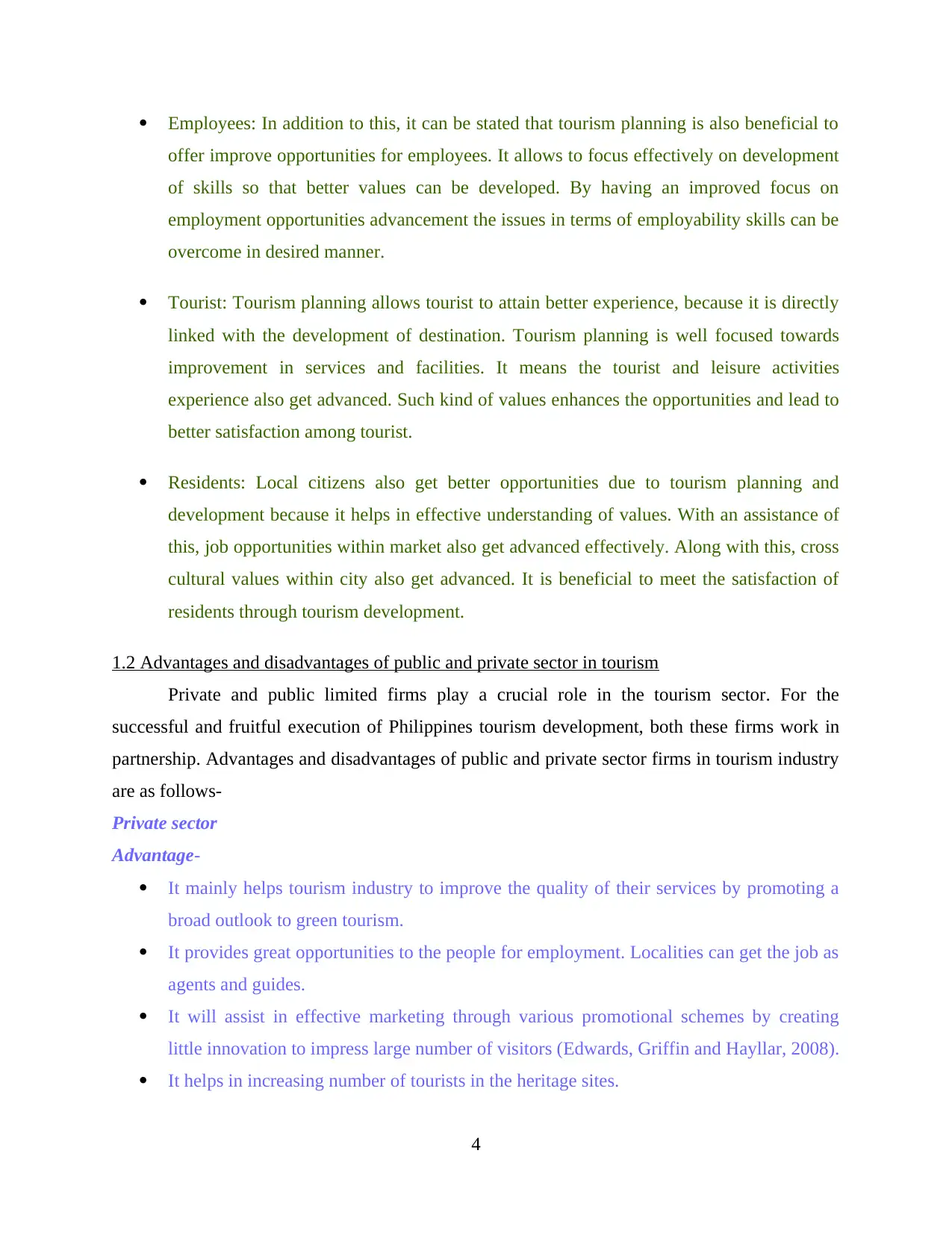
Employees: In addition to this, it can be stated that tourism planning is also beneficial to
offer improve opportunities for employees. It allows to focus effectively on development
of skills so that better values can be developed. By having an improved focus on
employment opportunities advancement the issues in terms of employability skills can be
overcome in desired manner.
Tourist: Tourism planning allows tourist to attain better experience, because it is directly
linked with the development of destination. Tourism planning is well focused towards
improvement in services and facilities. It means the tourist and leisure activities
experience also get advanced. Such kind of values enhances the opportunities and lead to
better satisfaction among tourist.
Residents: Local citizens also get better opportunities due to tourism planning and
development because it helps in effective understanding of values. With an assistance of
this, job opportunities within market also get advanced effectively. Along with this, cross
cultural values within city also get advanced. It is beneficial to meet the satisfaction of
residents through tourism development.
1.2 Advantages and disadvantages of public and private sector in tourism
Private and public limited firms play a crucial role in the tourism sector. For the
successful and fruitful execution of Philippines tourism development, both these firms work in
partnership. Advantages and disadvantages of public and private sector firms in tourism industry
are as follows-
Private sector
Advantage-
It mainly helps tourism industry to improve the quality of their services by promoting a
broad outlook to green tourism.
It provides great opportunities to the people for employment. Localities can get the job as
agents and guides.
It will assist in effective marketing through various promotional schemes by creating
little innovation to impress large number of visitors (Edwards, Griffin and Hayllar, 2008).
It helps in increasing number of tourists in the heritage sites.
4
offer improve opportunities for employees. It allows to focus effectively on development
of skills so that better values can be developed. By having an improved focus on
employment opportunities advancement the issues in terms of employability skills can be
overcome in desired manner.
Tourist: Tourism planning allows tourist to attain better experience, because it is directly
linked with the development of destination. Tourism planning is well focused towards
improvement in services and facilities. It means the tourist and leisure activities
experience also get advanced. Such kind of values enhances the opportunities and lead to
better satisfaction among tourist.
Residents: Local citizens also get better opportunities due to tourism planning and
development because it helps in effective understanding of values. With an assistance of
this, job opportunities within market also get advanced effectively. Along with this, cross
cultural values within city also get advanced. It is beneficial to meet the satisfaction of
residents through tourism development.
1.2 Advantages and disadvantages of public and private sector in tourism
Private and public limited firms play a crucial role in the tourism sector. For the
successful and fruitful execution of Philippines tourism development, both these firms work in
partnership. Advantages and disadvantages of public and private sector firms in tourism industry
are as follows-
Private sector
Advantage-
It mainly helps tourism industry to improve the quality of their services by promoting a
broad outlook to green tourism.
It provides great opportunities to the people for employment. Localities can get the job as
agents and guides.
It will assist in effective marketing through various promotional schemes by creating
little innovation to impress large number of visitors (Edwards, Griffin and Hayllar, 2008).
It helps in increasing number of tourists in the heritage sites.
4
⊘ This is a preview!⊘
Do you want full access?
Subscribe today to unlock all pages.

Trusted by 1+ million students worldwide
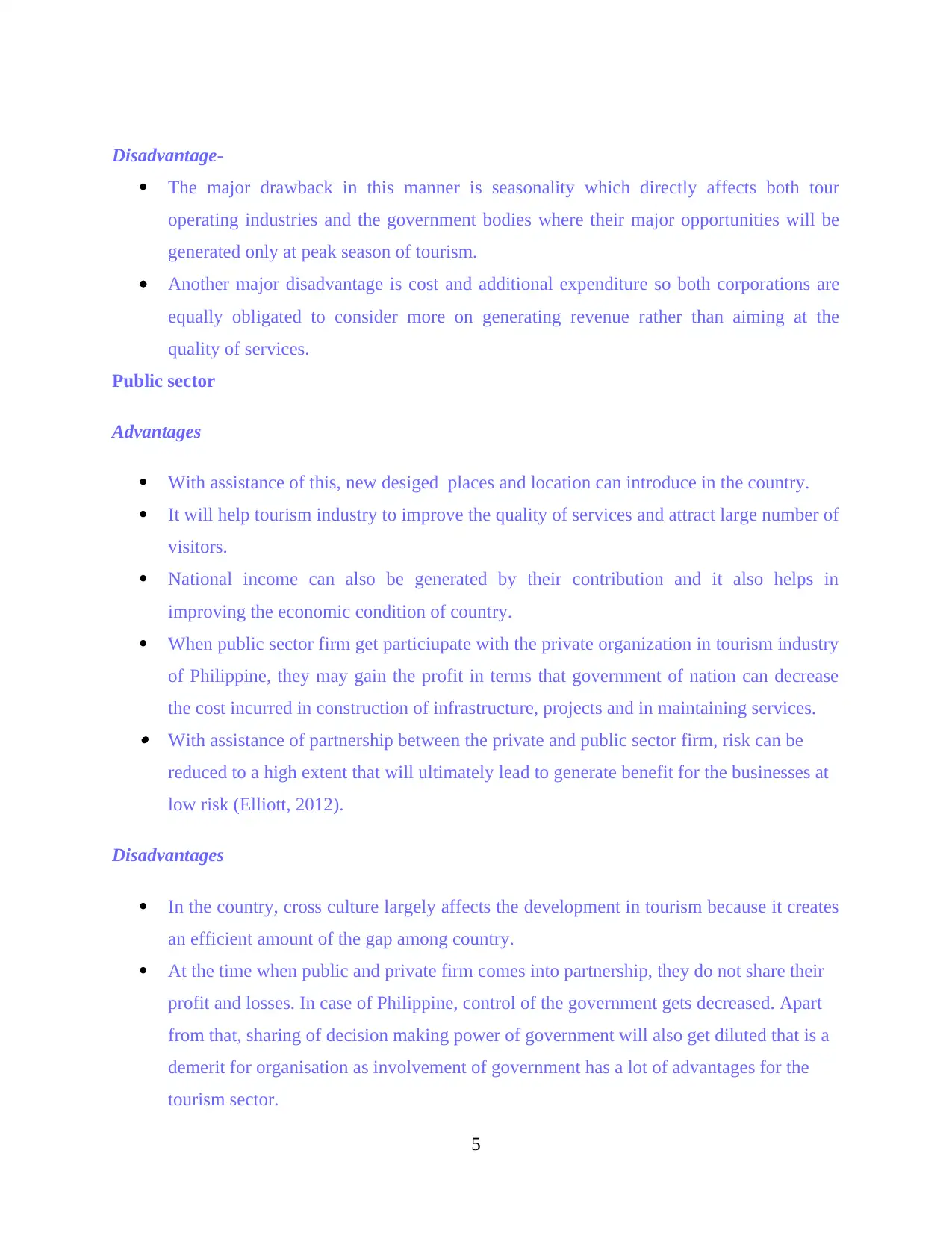
Disadvantage-
The major drawback in this manner is seasonality which directly affects both tour
operating industries and the government bodies where their major opportunities will be
generated only at peak season of tourism.
Another major disadvantage is cost and additional expenditure so both corporations are
equally obligated to consider more on generating revenue rather than aiming at the
quality of services.
Public sector
Advantages
With assistance of this, new desiged places and location can introduce in the country.
It will help tourism industry to improve the quality of services and attract large number of
visitors.
National income can also be generated by their contribution and it also helps in
improving the economic condition of country.
When public sector firm get particiupate with the private organization in tourism industry
of Philippine, they may gain the profit in terms that government of nation can decrease
the cost incurred in construction of infrastructure, projects and in maintaining services. With assistance of partnership between the private and public sector firm, risk can be
reduced to a high extent that will ultimately lead to generate benefit for the businesses at
low risk (Elliott, 2012).
Disadvantages
In the country, cross culture largely affects the development in tourism because it creates
an efficient amount of the gap among country.
At the time when public and private firm comes into partnership, they do not share their
profit and losses. In case of Philippine, control of the government gets decreased. Apart
from that, sharing of decision making power of government will also get diluted that is a
demerit for organisation as involvement of government has a lot of advantages for the
tourism sector.
5
The major drawback in this manner is seasonality which directly affects both tour
operating industries and the government bodies where their major opportunities will be
generated only at peak season of tourism.
Another major disadvantage is cost and additional expenditure so both corporations are
equally obligated to consider more on generating revenue rather than aiming at the
quality of services.
Public sector
Advantages
With assistance of this, new desiged places and location can introduce in the country.
It will help tourism industry to improve the quality of services and attract large number of
visitors.
National income can also be generated by their contribution and it also helps in
improving the economic condition of country.
When public sector firm get particiupate with the private organization in tourism industry
of Philippine, they may gain the profit in terms that government of nation can decrease
the cost incurred in construction of infrastructure, projects and in maintaining services. With assistance of partnership between the private and public sector firm, risk can be
reduced to a high extent that will ultimately lead to generate benefit for the businesses at
low risk (Elliott, 2012).
Disadvantages
In the country, cross culture largely affects the development in tourism because it creates
an efficient amount of the gap among country.
At the time when public and private firm comes into partnership, they do not share their
profit and losses. In case of Philippine, control of the government gets decreased. Apart
from that, sharing of decision making power of government will also get diluted that is a
demerit for organisation as involvement of government has a lot of advantages for the
tourism sector.
5
Paraphrase This Document
Need a fresh take? Get an instant paraphrase of this document with our AI Paraphraser
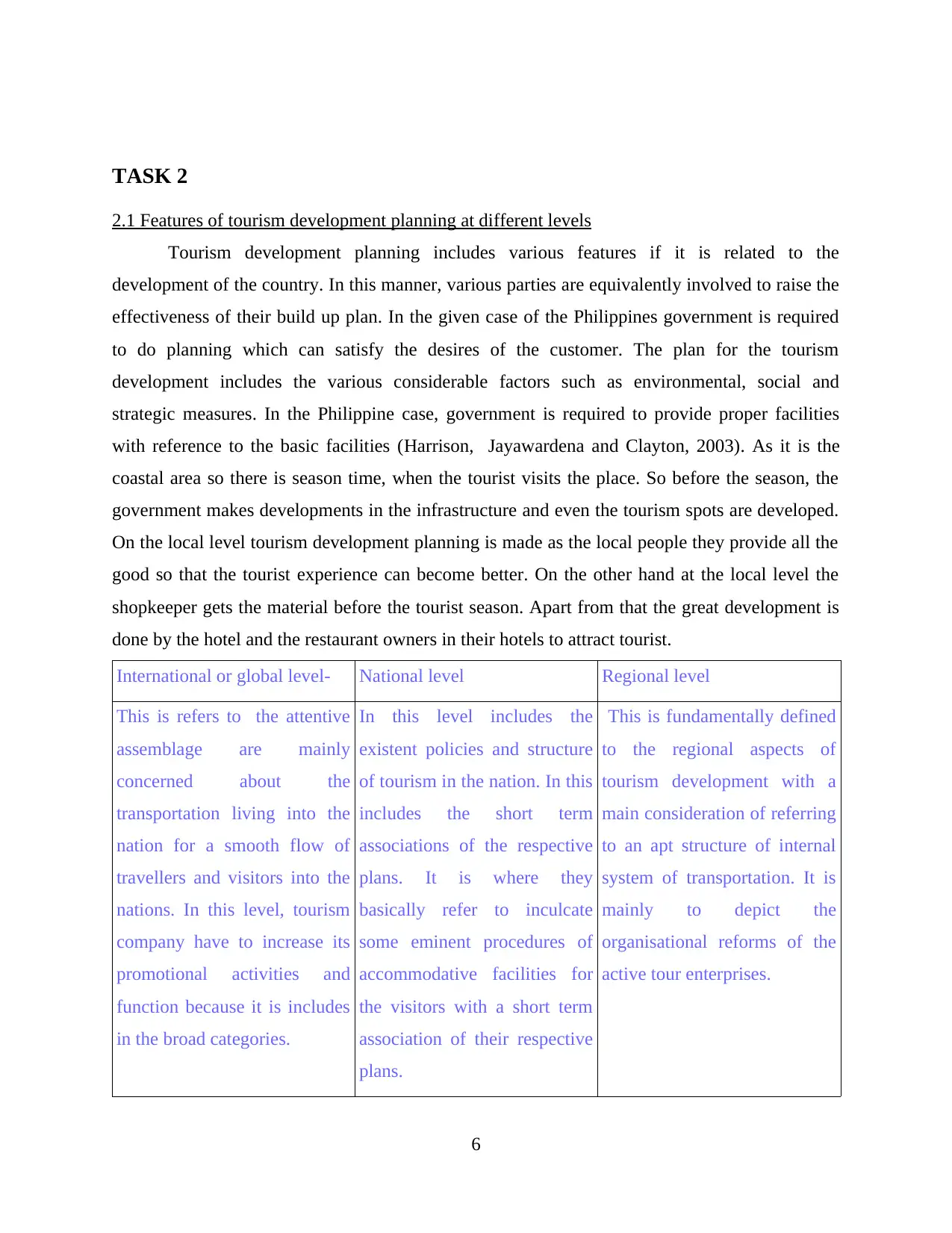
TASK 2
2.1 Features of tourism development planning at different levels
Tourism development planning includes various features if it is related to the
development of the country. In this manner, various parties are equivalently involved to raise the
effectiveness of their build up plan. In the given case of the Philippines government is required
to do planning which can satisfy the desires of the customer. The plan for the tourism
development includes the various considerable factors such as environmental, social and
strategic measures. In the Philippine case, government is required to provide proper facilities
with reference to the basic facilities (Harrison, Jayawardena and Clayton, 2003). As it is the
coastal area so there is season time, when the tourist visits the place. So before the season, the
government makes developments in the infrastructure and even the tourism spots are developed.
On the local level tourism development planning is made as the local people they provide all the
good so that the tourist experience can become better. On the other hand at the local level the
shopkeeper gets the material before the tourist season. Apart from that the great development is
done by the hotel and the restaurant owners in their hotels to attract tourist.
International or global level- National level Regional level
This is refers to the attentive
assemblage are mainly
concerned about the
transportation living into the
nation for a smooth flow of
travellers and visitors into the
nations. In this level, tourism
company have to increase its
promotional activities and
function because it is includes
in the broad categories.
In this level includes the
existent policies and structure
of tourism in the nation. In this
includes the short term
associations of the respective
plans. It is where they
basically refer to inculcate
some eminent procedures of
accommodative facilities for
the visitors with a short term
association of their respective
plans.
This is fundamentally defined
to the regional aspects of
tourism development with a
main consideration of referring
to an apt structure of internal
system of transportation. It is
mainly to depict the
organisational reforms of the
active tour enterprises.
6
2.1 Features of tourism development planning at different levels
Tourism development planning includes various features if it is related to the
development of the country. In this manner, various parties are equivalently involved to raise the
effectiveness of their build up plan. In the given case of the Philippines government is required
to do planning which can satisfy the desires of the customer. The plan for the tourism
development includes the various considerable factors such as environmental, social and
strategic measures. In the Philippine case, government is required to provide proper facilities
with reference to the basic facilities (Harrison, Jayawardena and Clayton, 2003). As it is the
coastal area so there is season time, when the tourist visits the place. So before the season, the
government makes developments in the infrastructure and even the tourism spots are developed.
On the local level tourism development planning is made as the local people they provide all the
good so that the tourist experience can become better. On the other hand at the local level the
shopkeeper gets the material before the tourist season. Apart from that the great development is
done by the hotel and the restaurant owners in their hotels to attract tourist.
International or global level- National level Regional level
This is refers to the attentive
assemblage are mainly
concerned about the
transportation living into the
nation for a smooth flow of
travellers and visitors into the
nations. In this level, tourism
company have to increase its
promotional activities and
function because it is includes
in the broad categories.
In this level includes the
existent policies and structure
of tourism in the nation. In this
includes the short term
associations of the respective
plans. It is where they
basically refer to inculcate
some eminent procedures of
accommodative facilities for
the visitors with a short term
association of their respective
plans.
This is fundamentally defined
to the regional aspects of
tourism development with a
main consideration of referring
to an apt structure of internal
system of transportation. It is
mainly to depict the
organisational reforms of the
active tour enterprises.
6
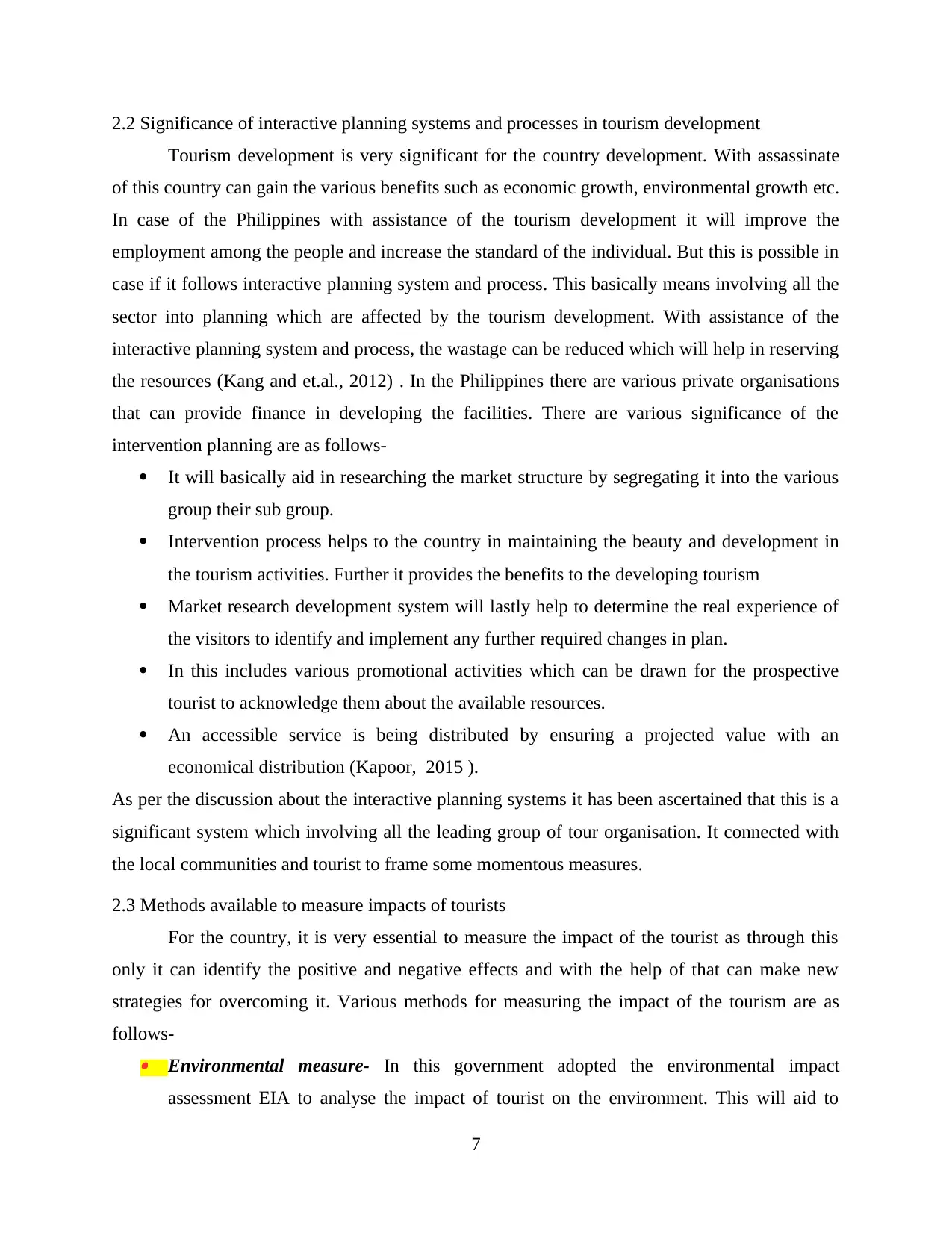
2.2 Significance of interactive planning systems and processes in tourism development
Tourism development is very significant for the country development. With assassinate
of this country can gain the various benefits such as economic growth, environmental growth etc.
In case of the Philippines with assistance of the tourism development it will improve the
employment among the people and increase the standard of the individual. But this is possible in
case if it follows interactive planning system and process. This basically means involving all the
sector into planning which are affected by the tourism development. With assistance of the
interactive planning system and process, the wastage can be reduced which will help in reserving
the resources (Kang and et.al., 2012) . In the Philippines there are various private organisations
that can provide finance in developing the facilities. There are various significance of the
intervention planning are as follows-
It will basically aid in researching the market structure by segregating it into the various
group their sub group.
Intervention process helps to the country in maintaining the beauty and development in
the tourism activities. Further it provides the benefits to the developing tourism
Market research development system will lastly help to determine the real experience of
the visitors to identify and implement any further required changes in plan.
In this includes various promotional activities which can be drawn for the prospective
tourist to acknowledge them about the available resources.
An accessible service is being distributed by ensuring a projected value with an
economical distribution (Kapoor, 2015 ).
As per the discussion about the interactive planning systems it has been ascertained that this is a
significant system which involving all the leading group of tour organisation. It connected with
the local communities and tourist to frame some momentous measures.
2.3 Methods available to measure impacts of tourists
For the country, it is very essential to measure the impact of the tourist as through this
only it can identify the positive and negative effects and with the help of that can make new
strategies for overcoming it. Various methods for measuring the impact of the tourism are as
follows- Environmental measure- In this government adopted the environmental impact
assessment EIA to analyse the impact of tourist on the environment. This will aid to
7
Tourism development is very significant for the country development. With assassinate
of this country can gain the various benefits such as economic growth, environmental growth etc.
In case of the Philippines with assistance of the tourism development it will improve the
employment among the people and increase the standard of the individual. But this is possible in
case if it follows interactive planning system and process. This basically means involving all the
sector into planning which are affected by the tourism development. With assistance of the
interactive planning system and process, the wastage can be reduced which will help in reserving
the resources (Kang and et.al., 2012) . In the Philippines there are various private organisations
that can provide finance in developing the facilities. There are various significance of the
intervention planning are as follows-
It will basically aid in researching the market structure by segregating it into the various
group their sub group.
Intervention process helps to the country in maintaining the beauty and development in
the tourism activities. Further it provides the benefits to the developing tourism
Market research development system will lastly help to determine the real experience of
the visitors to identify and implement any further required changes in plan.
In this includes various promotional activities which can be drawn for the prospective
tourist to acknowledge them about the available resources.
An accessible service is being distributed by ensuring a projected value with an
economical distribution (Kapoor, 2015 ).
As per the discussion about the interactive planning systems it has been ascertained that this is a
significant system which involving all the leading group of tour organisation. It connected with
the local communities and tourist to frame some momentous measures.
2.3 Methods available to measure impacts of tourists
For the country, it is very essential to measure the impact of the tourist as through this
only it can identify the positive and negative effects and with the help of that can make new
strategies for overcoming it. Various methods for measuring the impact of the tourism are as
follows- Environmental measure- In this government adopted the environmental impact
assessment EIA to analyse the impact of tourist on the environment. This will aid to
7
⊘ This is a preview!⊘
Do you want full access?
Subscribe today to unlock all pages.

Trusted by 1+ million students worldwide
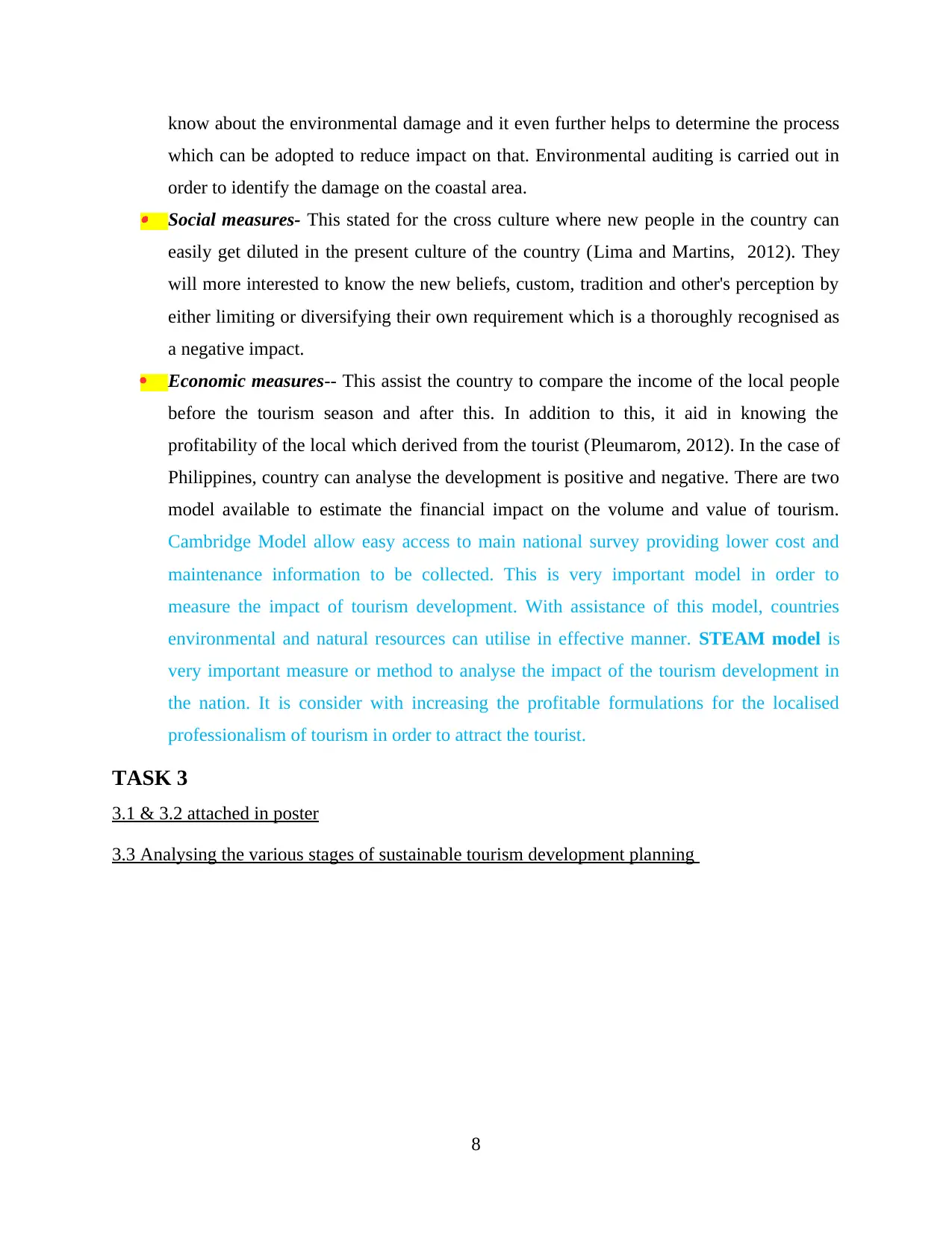
know about the environmental damage and it even further helps to determine the process
which can be adopted to reduce impact on that. Environmental auditing is carried out in
order to identify the damage on the coastal area. Social measures- This stated for the cross culture where new people in the country can
easily get diluted in the present culture of the country (Lima and Martins, 2012). They
will more interested to know the new beliefs, custom, tradition and other's perception by
either limiting or diversifying their own requirement which is a thoroughly recognised as
a negative impact.
Economic measures-- This assist the country to compare the income of the local people
before the tourism season and after this. In addition to this, it aid in knowing the
profitability of the local which derived from the tourist (Pleumarom, 2012). In the case of
Philippines, country can analyse the development is positive and negative. There are two
model available to estimate the financial impact on the volume and value of tourism.
Cambridge Model allow easy access to main national survey providing lower cost and
maintenance information to be collected. This is very important model in order to
measure the impact of tourism development. With assistance of this model, countries
environmental and natural resources can utilise in effective manner. STEAM model is
very important measure or method to analyse the impact of the tourism development in
the nation. It is consider with increasing the profitable formulations for the localised
professionalism of tourism in order to attract the tourist.
TASK 3
3.1 & 3.2 attached in poster
3.3 Analysing the various stages of sustainable tourism development planning
8
which can be adopted to reduce impact on that. Environmental auditing is carried out in
order to identify the damage on the coastal area. Social measures- This stated for the cross culture where new people in the country can
easily get diluted in the present culture of the country (Lima and Martins, 2012). They
will more interested to know the new beliefs, custom, tradition and other's perception by
either limiting or diversifying their own requirement which is a thoroughly recognised as
a negative impact.
Economic measures-- This assist the country to compare the income of the local people
before the tourism season and after this. In addition to this, it aid in knowing the
profitability of the local which derived from the tourist (Pleumarom, 2012). In the case of
Philippines, country can analyse the development is positive and negative. There are two
model available to estimate the financial impact on the volume and value of tourism.
Cambridge Model allow easy access to main national survey providing lower cost and
maintenance information to be collected. This is very important model in order to
measure the impact of tourism development. With assistance of this model, countries
environmental and natural resources can utilise in effective manner. STEAM model is
very important measure or method to analyse the impact of the tourism development in
the nation. It is consider with increasing the profitable formulations for the localised
professionalism of tourism in order to attract the tourist.
TASK 3
3.1 & 3.2 attached in poster
3.3 Analysing the various stages of sustainable tourism development planning
8
Paraphrase This Document
Need a fresh take? Get an instant paraphrase of this document with our AI Paraphraser
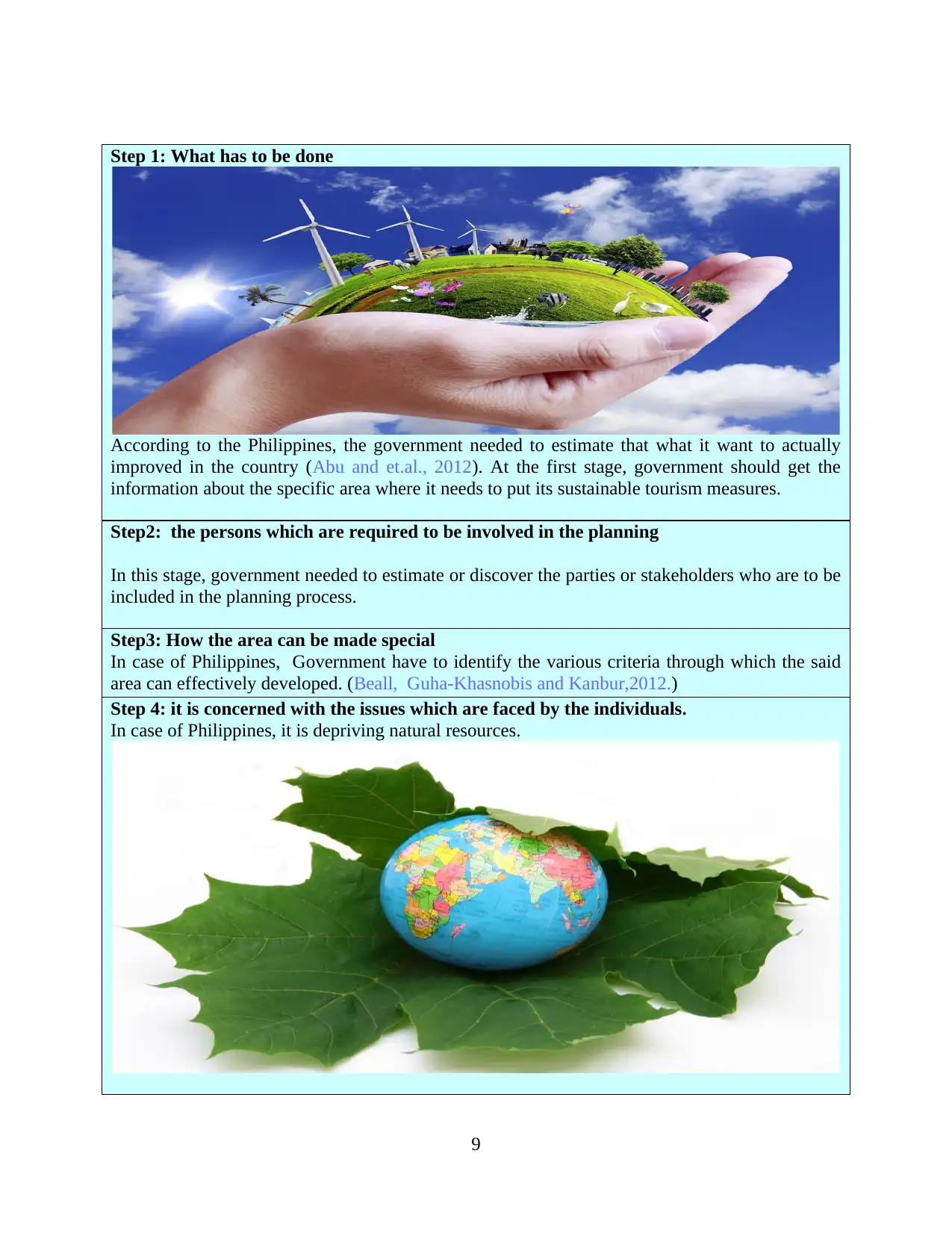
Step 1: What has to be done
According to the Philippines, the government needed to estimate that what it want to actually
improved in the country (Abu and et.al., 2012). At the first stage, government should get the
information about the specific area where it needs to put its sustainable tourism measures.
Step2: the persons which are required to be involved in the planning
In this stage, government needed to estimate or discover the parties or stakeholders who are to be
included in the planning process.
Step3: How the area can be made special
In case of Philippines, Government have to identify the various criteria through which the said
area can effectively developed. (Beall, Guha-Khasnobis and Kanbur,2012.)
Step 4: it is concerned with the issues which are faced by the individuals.
In case of Philippines, it is depriving natural resources.
9
According to the Philippines, the government needed to estimate that what it want to actually
improved in the country (Abu and et.al., 2012). At the first stage, government should get the
information about the specific area where it needs to put its sustainable tourism measures.
Step2: the persons which are required to be involved in the planning
In this stage, government needed to estimate or discover the parties or stakeholders who are to be
included in the planning process.
Step3: How the area can be made special
In case of Philippines, Government have to identify the various criteria through which the said
area can effectively developed. (Beall, Guha-Khasnobis and Kanbur,2012.)
Step 4: it is concerned with the issues which are faced by the individuals.
In case of Philippines, it is depriving natural resources.
9
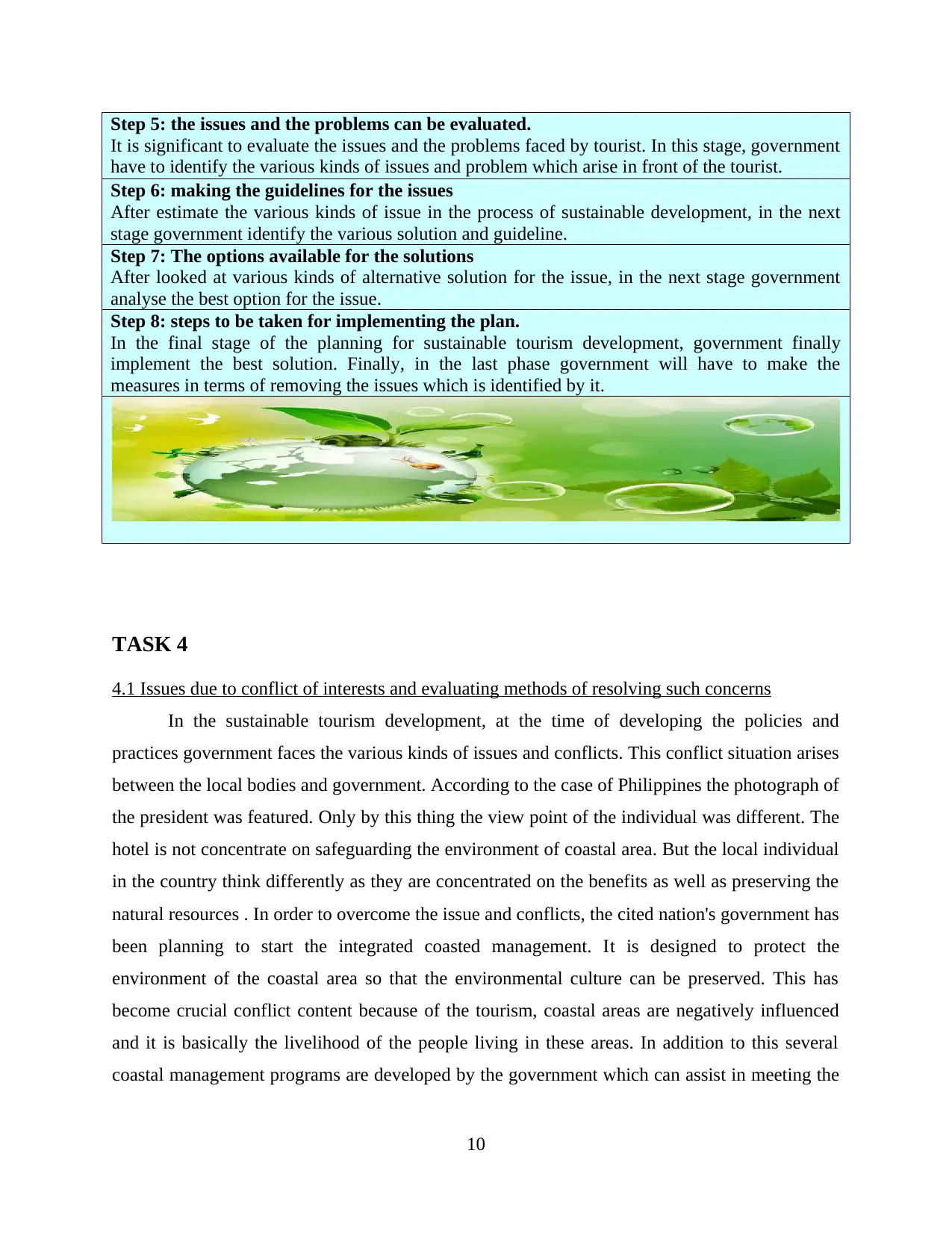
Step 5: the issues and the problems can be evaluated.
It is significant to evaluate the issues and the problems faced by tourist. In this stage, government
have to identify the various kinds of issues and problem which arise in front of the tourist.
Step 6: making the guidelines for the issues
After estimate the various kinds of issue in the process of sustainable development, in the next
stage government identify the various solution and guideline.
Step 7: The options available for the solutions
After looked at various kinds of alternative solution for the issue, in the next stage government
analyse the best option for the issue.
Step 8: steps to be taken for implementing the plan.
In the final stage of the planning for sustainable tourism development, government finally
implement the best solution. Finally, in the last phase government will have to make the
measures in terms of removing the issues which is identified by it.
TASK 4
4.1 Issues due to conflict of interests and evaluating methods of resolving such concerns
In the sustainable tourism development, at the time of developing the policies and
practices government faces the various kinds of issues and conflicts. This conflict situation arises
between the local bodies and government. According to the case of Philippines the photograph of
the president was featured. Only by this thing the view point of the individual was different. The
hotel is not concentrate on safeguarding the environment of coastal area. But the local individual
in the country think differently as they are concentrated on the benefits as well as preserving the
natural resources . In order to overcome the issue and conflicts, the cited nation's government has
been planning to start the integrated coasted management. It is designed to protect the
environment of the coastal area so that the environmental culture can be preserved. This has
become crucial conflict content because of the tourism, coastal areas are negatively influenced
and it is basically the livelihood of the people living in these areas. In addition to this several
coastal management programs are developed by the government which can assist in meeting the
10
It is significant to evaluate the issues and the problems faced by tourist. In this stage, government
have to identify the various kinds of issues and problem which arise in front of the tourist.
Step 6: making the guidelines for the issues
After estimate the various kinds of issue in the process of sustainable development, in the next
stage government identify the various solution and guideline.
Step 7: The options available for the solutions
After looked at various kinds of alternative solution for the issue, in the next stage government
analyse the best option for the issue.
Step 8: steps to be taken for implementing the plan.
In the final stage of the planning for sustainable tourism development, government finally
implement the best solution. Finally, in the last phase government will have to make the
measures in terms of removing the issues which is identified by it.
TASK 4
4.1 Issues due to conflict of interests and evaluating methods of resolving such concerns
In the sustainable tourism development, at the time of developing the policies and
practices government faces the various kinds of issues and conflicts. This conflict situation arises
between the local bodies and government. According to the case of Philippines the photograph of
the president was featured. Only by this thing the view point of the individual was different. The
hotel is not concentrate on safeguarding the environment of coastal area. But the local individual
in the country think differently as they are concentrated on the benefits as well as preserving the
natural resources . In order to overcome the issue and conflicts, the cited nation's government has
been planning to start the integrated coasted management. It is designed to protect the
environment of the coastal area so that the environmental culture can be preserved. This has
become crucial conflict content because of the tourism, coastal areas are negatively influenced
and it is basically the livelihood of the people living in these areas. In addition to this several
coastal management programs are developed by the government which can assist in meeting the
10
⊘ This is a preview!⊘
Do you want full access?
Subscribe today to unlock all pages.

Trusted by 1+ million students worldwide
1 out of 19
Related Documents
Your All-in-One AI-Powered Toolkit for Academic Success.
+13062052269
info@desklib.com
Available 24*7 on WhatsApp / Email
![[object Object]](/_next/static/media/star-bottom.7253800d.svg)
Unlock your academic potential
Copyright © 2020–2025 A2Z Services. All Rights Reserved. Developed and managed by ZUCOL.





